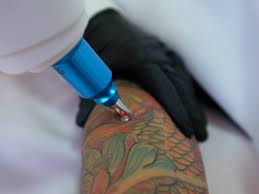When planning for tattoo removal in riyadh, one of the most common goals people have is preparing their skin for a new tattoo. Cover-up tattoos have become a popular option for those who don’t necessarily want their old tattoo gone completely—but rather want to replace it with something new and meaningful. The key question is: how many laser sessions are needed before you can safely get a cover-up?
Why Fade Before a Cover-Up:
Getting a laser treatment before your new tattoo helps create a cleaner canvas. The purpose of fading is not to erase the tattoo entirely but to lighten it enough so your tattoo artist can easily design and apply a new piece without old colors showing through.
Benefits of Tattoo Fading for Cover-Ups:
-
Improves clarity of the new tattoo design
-
Prevents color interference from old pigments
-
Enhances ink brightness and longevity
-
Gives artists flexibility with new colors and shading
How Laser Tattoo Removal Prepares the Skin:
During each laser session, the device emits short pulses of light that shatter the ink particles under the skin. Over the following weeks, the body’s immune system gradually removes those particles, fading the tattoo more with every session.
How It Works:
-
Assessment: The tattoo is examined for color depth, ink type, and size.
-
Laser Treatment: Specific wavelengths target the pigment without damaging nearby skin.
-
Healing: The skin clears out ink fragments naturally, leaving a lighter result after each session.
How Many Sessions Are Needed Before a Cover-Up:
The number of sessions required varies based on your tattoo’s characteristics. On average, 2 to 5 sessions are enough to fade a tattoo for a new cover-up.
| Tattoo Type | Average Fading Sessions | Time Between Sessions | Ideal Healing Period Before Cover-Up |
|---|---|---|---|
| Small/Light Tattoo | 2–3 | 4–6 weeks | 6–8 weeks |
| Medium Tattoo | 3–4 | 6–8 weeks | 8–10 weeks |
| Large or Dense Tattoo | 4–5 | 8–10 weeks | 10–12 weeks |
Your dermatologist will recommend the exact number of sessions depending on the ink saturation, placement, and desired level of fading.
Key Factors That Influence Fading Speed:
1. Tattoo Age:
Older tattoos fade faster because ink naturally breaks down over time.
2. Ink Colors:
Dark inks like black and navy fade quickly, while lighter shades such as green or yellow may take more sessions.
3. Skin Tone:
Different skin types require different wavelengths for safe fading. Experts adjust settings to protect melanin and avoid pigment changes.
4. Laser Type:
Advanced lasers like the Pico and Q-switched systems provide faster fading with minimal side effects.
Timing Between Laser and New Tattoo:
Even after your final fading session, your skin needs time to heal before getting a new tattoo. The typical waiting period is at least 6–8 weeks after your last laser session. This allows your skin to regenerate and ensures better ink absorption during your new tattoo application.
Why Choose Enfield Royal Saudi for Safe Laser Fading:
For safe and effective results, Enfield Royal Saudi provides advanced laser systems that suit all skin tones and tattoo types. Their certified dermatologists carefully assess your tattoo and design a personalized treatment plan to fade it to the ideal level—without causing damage or scarring.
Their reputation for precision extends beyond tattoo removal. They are also well known for aesthetic procedures such as dermal fillers in Riyadh, facial fillers in Riyadh, and dermal filler chin filler in Riyadh, giving clients the chance to rejuvenate their look once their skin is clear.
Preparing for the Perfect Cover-Up:
Tips for Best Results:
-
Consult both your dermatologist and tattoo artist. Communication ensures that the fading level matches your cover-up design.
-
Stick to your treatment schedule. Missing sessions can delay your desired outcome.
-
Follow aftercare instructions. Proper healing leads to smoother and clearer skin.
-
Stay hydrated and avoid sun exposure. Both help your body eliminate pigment more efficiently.
Avoid These Mistakes:
-
Don’t rush into a cover-up before the skin fully heals.
-
Avoid using harsh skincare products on the treated area.
-
Never attempt DIY fading creams—they can irritate or damage your skin.
The Transformation Process — Old to New:
Laser tattoo fading offers a second chance for creativity. You can remove parts of an old design, fade unwanted colors, and replace them with something more personal and meaningful. The result is a seamless new tattoo that looks fresh and professionally done.
Final Thoughts:
So, can you get a cover-up tattoo after removal — and how many sessions first? Yes, absolutely. With proper planning and expert guidance, your old tattoo can be safely lightened in just a few sessions. Allow your skin the necessary time to heal before getting inked again to ensure the best results.
At Enfield RoyaLSaudi, specialists combine artistry and advanced technology to prepare your skin for a flawless cover-up transformation. Their experience in laser precision and complementary treatments like dermal fillers ensures that your skin looks healthy, smooth, and ready for its new story.







0 Comments